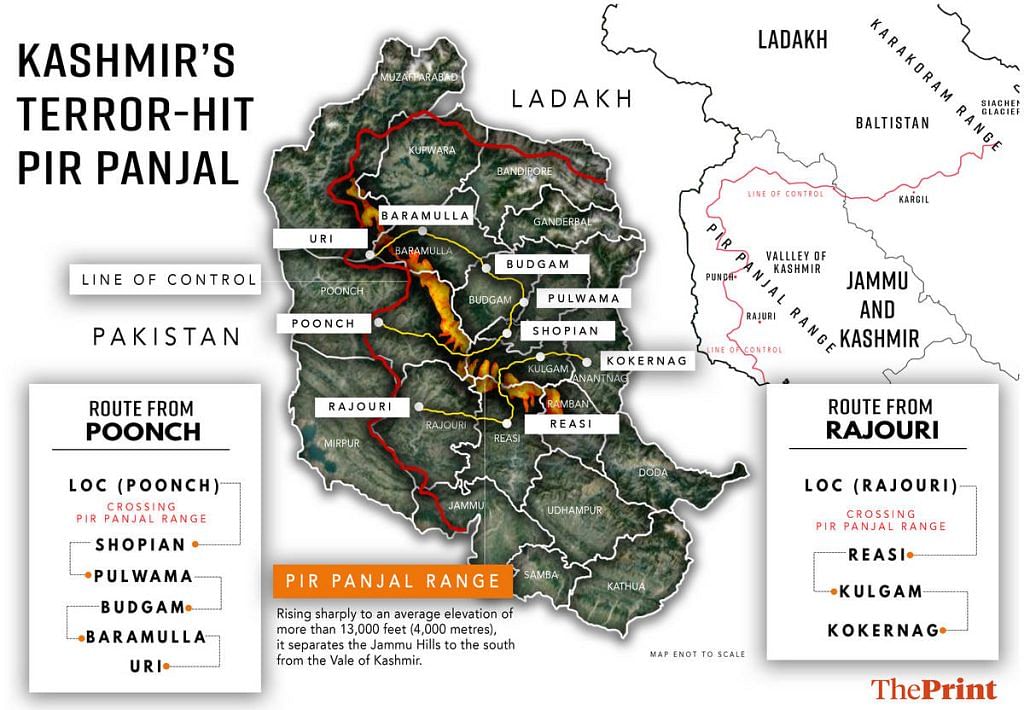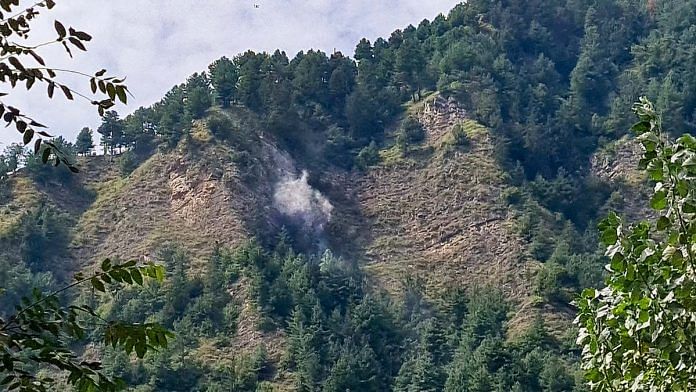New Delhi: As the sun rose above the Pir Panjal foothills, gunfire echoed through the Garol forest area of Kokernag in Anantnag district of south Kashmir. Amid a counter-terrorism operation, three officers, two from the army and one from the police, lost their lives Wednesday. A fourth soldier was also reportedly found dead Friday as the operations against militants continued into the third day.
The killings were a grim reminder of growing militant activities in the Pir Panjal region, which spans the Poonch and Rajouri districts of Jammu, contiguous to Kulgam and Anantnag in Kashmir.
The Garol area, the stage for the latest tragedy, sits at the foothills of the Pir Panjal range. The incident here marks the second time in just over a month that such ambushes have occurred in the region. On 4 August, the Halan forest in Kulgam district witnessed the loss of three soldiers from the 34 Rashtriya Rifles.
ThePrint takes a look at how Pir Panjal region of Jammu and Kashmir is becoming a hotbed of militancy.
Also Read: New terror tactics — lethal Kokernag ambush illustrates jihadist strategy aimed at tying down troops
‘LoC in these districts is very porous’
The interiors of the Garol and Halal forests, where the two incidents took place, connect Kulgam and Kokernag to Kishtwar in Jammu. This hilly and forested terrain provides easy access to Shopian’s forests and onwards to Poonch.
Over the last couple of years, the Pir Panjal valley has witnessed a surge in militancy-related incidents, with 25 reportedly soldiers losing their lives in these areas in this span.
Sources in the Army and J&K police attribute this to the relentless anti-terrorism operations in Kashmir, which has pushed insurgents into the mountains, where they hide and wait for the right moment to enter the valley.
But for locals, militancy has once again descended upon Jammu. The geographical terrain and contiguous borders connecting Pakistan to the Pir Panjal, and subsequently to Kashmir, are the key reasons.
The hilly districts of Poonch and Rajouri, flanking the 225 km Line of Control (LOC) constitute the Pir Panjal region, with borders contiguous to Kulgam and Anantnag.
“The Line of Control in these districts is very porous and there are a lot of rivers and ravines helping terrorists move to the other side,” explained Zafar Chaudhary, a prominent J&K journalist.
He added that terrorists sneak into the villages near the LoC and easily blend with the populace near the LOC, taking advantage of the similar demographics on both sides of the border.
The Pir Panjal range, a cluster of lower mountains in the Western Himalayas, extends from the Nilam River in western Pakistan-occupied Kashmir, through southwestern J&K, to the Upper Beas River in northwestern Himachal Pradesh. In Jammu, it stretches from Poonch in the west to Doda in the east.
A three-day trek through the Pir Panjal mountain passes and ridges in Rajouri district can transport insurgent groups to Kokernag in Anantnag, where this week’s killings unfolded.
Historically, too, the mountains of Rajouri and Poonch have served as routes for militants in transit, according to sources in the Army. Insurgent groups would enter Jammu through the LoC in these districts, stay put for a few days, and then trek on to Kashmir.

“Once a terrorist has entered Rajouri, he can reach Kulgam through the mountains and then to Kokernag. In the same manner, Shopian and Uri can be easily reached through Poonch. The terrorists from Pakistan are trained and physically fit. They can trek faster than an average man. Also, they don’t fear for their life,” said a senior army official.
Among the Bakarwal herding community here, there’s a famous local adage: “If you know the Pir Panjal mountains, you know Kashmir.”
During the summer, these nomadic shepherds traverse the upper reaches of the Pir Panjal with their flocks, crossing mountain passes to enter the Kashmir Valley. During their seasonal stay in the hilly terrains, they make mud-wood houses, locally known as dhok.
In attacks earlier this year in Rajouri and Poonch, police sources said that it was suspected that the insurgent groups had occupied dhoks where they had kept their weapons and used as bases while they conducted a reconnaissance of the area.
Ten soldiers were killed within a fortnight in April and May in twin attacks that occurred in forested areas of Rajouri and Poonch.
This was regarded as a tactical shift in militancy from Kashmir to the mountainous regions of Pir Panjal, which offered an entry point into the valley. According to army officials, the initial signs of this shift became apparent in February 2021 when sporadic incidents — such as the recovery of 15 ‘sticky bombs’ in Samba district’s Ramgarh sector along the International Border (IB) with Pakistan and the dropping of drones in Jammu — were recorded.
Notably, last month, a Hizbul Mujahideen “divisional commander” was killed while attempting to infiltrate along the Line of Control (LoC) in Poonch district. The army had stated that this militant, Muneser Hussain, a native of Poonch who had crossed over to Pakistan in the 1990s, was assigned the task of reviving militancy in the Pir Panjal districts of Poonch and Rajouri.
‘Local support’
While the spotlight has typically been on militancy in Kashmir, the contribution of the Jammu region in facilitating militant infiltration into the Valley often goes unnoticed.
On 7 September, J&K Director General of Police (DGP) Dilbagh Singh acknowledged the presence of 12 “foreign terrorists active in districts of Poonch and Rajouri”. He also noted that these terrorists frequently moved between Kulgam-Shopian and Rajouri-Poonch.
In July, Operation Trinetra, launched by the Indian Army to neutralise insurgents hiding in Rajouri and Poonch, was deemed a success. The operation involved tight vigil, random checks, and heightened surveillance across the LoC and the forests.
But journalist Chaudhary claimed that this time the militancy in this region is more transient than it was earlier.
“Over the past two to three years, militants are not only using the routes of Poonch and Rajouri to access the Valley, but have also become active in these regions. But this time, they are not staying. They come, execute an operation, and go back the next morning with ease,” he said.
It’s a fresh challenge for the J&K Police. Meetings upon meetings have been convened following the Kokernag incident. Discussions are centring on Pakistan’s new strategy of diverting attention towards the Pir Panjal by unsettling adjacent areas, sources in the police said. Now, Village Defence Committees have been mobilised, and surveillance along the Rajouri and Poonch LOC has been tightened.
Sources within the J&K Police also told ThePrint that militancy once again enjoys support from a section of locals in these districts, enabling attacks and easy retreats into the forests. And this time, it’s not local militancy but well-trained, hardened militants sent by Pakistan.
“Regular combing operations are taken out. There are a lot of chases in the dense interiors of the Pir Panjal forests. We along with the other security forces have been able to stop many such operations. So there is surveillance, patrolling, we are keeping an eye on everything— but they will make a small tunnel, come in, execute an operation, go back, or get killed. The challenges are many,” said a senior police officer.
This isn’t the first time such events have unfolded.
In the 1990s, during the peak of militancy, the rugged terrain and dense forests of the Pir Panjal range provided a safe haven for militants making their way from Pakistan. Some settled in districts like Poonch, Rajouri, Doda, and Kishtwar within the Jammu region.
Reflecting on those times, Brigadier Neeraj Bali (Retd), who served in these areas during the ’90s and early 2000s, noted: “I have found that the districts of Poonch and Rajouri are easier to infiltrate and the mountains can be scaled easily. What is surprising is that areas of Rajouri, Surankote, Poonch, and Kalakote became active after the militants got the support of a section of population. The point is that the population are essentially Pahari-speaking Kashmiris.”
(This is an updated version of this report)
(Edited by Asavari Singh)
Also Read: Anantnag encounter: Intel-based ops gone haywire, more casualties feared, hunt for 2 terrorists on



